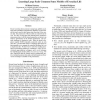Free Online Productivity Tools
i2Speak
i2Symbol
i2OCR
iTex2Img
iWeb2Print
iWeb2Shot
i2Type
iPdf2Split
iPdf2Merge
i2Bopomofo
i2Arabic
i2Style
i2Image
i2PDF
iLatex2Rtf
Sci2ools
AAAI
2007
2007
Learning Large Scale Common Sense Models of Everyday Life
Recent work has shown promise in using large, publicly available, hand-contributed commonsense databases as joint models that can be used to infer human state from day-to-day sensor data. The parameters of these models are mined from the web. We show in this paper that learning these parameters using sensor data (with the mined parameters as priors) can improve performance of the models significantly. The primary challenge in learning is scale. Since the model comprises roughly 50,000 irregularly connected nodes in each time slice, it is intractable either to completely label observed data manually or to compute the expected likelihood of even a single time slice. We show how to solve the resulting semisupervised learning problem by combining a variety of conventional approximation techniques and a novel technique for simplifying the model called context-based pruning. We show empirically that the learned model is substantially better at interpreting sensor data and an detailed analy...
| Added | 02 Oct 2010 |
| Updated | 02 Oct 2010 |
| Type | Conference |
| Year | 2007 |
| Where | AAAI |
| Authors | William Pentney, Matthai Philipose, Jeff A. Bilmes, Henry A. Kautz |
Comments (0)

